[English] 日本語
 Yorodumi
Yorodumi- PDB-6j5w: Ligand-triggered allosteric ADP release primes a plant NLR complex -
+ Open data
Open data
- Basic information
Basic information
| Entry | Database: PDB / ID: 6j5w | |||||||||
|---|---|---|---|---|---|---|---|---|---|---|
| Title | Ligand-triggered allosteric ADP release primes a plant NLR complex | |||||||||
 Components Components |
| |||||||||
 Keywords Keywords | PLANT PROTEIN / ZAR1 / RKS1 | |||||||||
| Function / homology |  Function and homology information Function and homology informationpositive regulation of defense response to bacterium / response to temperature stimulus / regulation of immune response / ADP binding / kinase activity / defense response to Gram-negative bacterium / cell surface receptor signaling pathway / non-specific serine/threonine protein kinase / protein kinase activity / defense response to bacterium ...positive regulation of defense response to bacterium / response to temperature stimulus / regulation of immune response / ADP binding / kinase activity / defense response to Gram-negative bacterium / cell surface receptor signaling pathway / non-specific serine/threonine protein kinase / protein kinase activity / defense response to bacterium / ATP binding / nucleus / plasma membrane Similarity search - Function | |||||||||
| Biological species |  | |||||||||
| Method | ELECTRON MICROSCOPY / single particle reconstruction / cryo EM / Resolution: 3.7 Å | |||||||||
 Authors Authors | Wang, J.Z. / Wang, J. / Hu, M.J. / Wang, H.W. / Zhou, J.M. / Chai, J.J. | |||||||||
| Funding support |  China, 2items China, 2items
| |||||||||
 Citation Citation |  Journal: Science / Year: 2019 Journal: Science / Year: 2019Title: Ligand-triggered allosteric ADP release primes a plant NLR complex. Authors: Jizong Wang / Jia Wang / Meijuan Hu / Shan Wu / Jinfeng Qi / Guoxun Wang / Zhifu Han / Yijun Qi / Ning Gao / Hong-Wei Wang / Jian-Min Zhou / Jijie Chai /   Abstract: Pathogen recognition by nucleotide-binding (NB), leucine-rich repeat (LRR) receptors (NLRs) plays roles in plant immunity. The pv. effector AvrAC uridylylates the PBL2 kinase, and the latter (PBL2) ...Pathogen recognition by nucleotide-binding (NB), leucine-rich repeat (LRR) receptors (NLRs) plays roles in plant immunity. The pv. effector AvrAC uridylylates the PBL2 kinase, and the latter (PBL2) acts as a ligand to activate the NLR ZAR1 precomplexed with the RKS1 pseudokinase. Here we report the cryo-electron microscopy structures of ZAR1-RKS1 and ZAR1-RKS1-PBL2 in an inactive and intermediate state, respectively. The ZAR1 domain, compared with animal NLR domains, is differently positioned to sequester ZAR1 in an inactive state. Recognition of PBL2 is exclusively through RKS1, which interacts with ZAR1 PBL2 binding stabilizes the RKS1 activation segment, which sterically blocks ZAR1 adenosine diphosphate (ADP) binding. This engenders a more flexible NB domain without conformational changes in the other ZAR1 domains. Our study provides a structural template for understanding plant NLRs. | |||||||||
| History |
|
- Structure visualization
Structure visualization
| Movie |
 Movie viewer Movie viewer |
|---|---|
| Structure viewer | Molecule:  Molmil Molmil Jmol/JSmol Jmol/JSmol |
- Downloads & links
Downloads & links
- Download
Download
| PDBx/mmCIF format |  6j5w.cif.gz 6j5w.cif.gz | 210.2 KB | Display |  PDBx/mmCIF format PDBx/mmCIF format |
|---|---|---|---|---|
| PDB format |  pdb6j5w.ent.gz pdb6j5w.ent.gz | 164.6 KB | Display |  PDB format PDB format |
| PDBx/mmJSON format |  6j5w.json.gz 6j5w.json.gz | Tree view |  PDBx/mmJSON format PDBx/mmJSON format | |
| Others |  Other downloads Other downloads |
-Validation report
| Summary document |  6j5w_validation.pdf.gz 6j5w_validation.pdf.gz | 827.6 KB | Display |  wwPDB validaton report wwPDB validaton report |
|---|---|---|---|---|
| Full document |  6j5w_full_validation.pdf.gz 6j5w_full_validation.pdf.gz | 837.7 KB | Display | |
| Data in XML |  6j5w_validation.xml.gz 6j5w_validation.xml.gz | 34.4 KB | Display | |
| Data in CIF |  6j5w_validation.cif.gz 6j5w_validation.cif.gz | 52.8 KB | Display | |
| Arichive directory |  https://data.pdbj.org/pub/pdb/validation_reports/j5/6j5w https://data.pdbj.org/pub/pdb/validation_reports/j5/6j5w ftp://data.pdbj.org/pub/pdb/validation_reports/j5/6j5w ftp://data.pdbj.org/pub/pdb/validation_reports/j5/6j5w | HTTPS FTP |
-Related structure data
| Related structure data |  0683MC  0681C  0682C  6j5uC  6j5vC M: map data used to model this data C: citing same article ( |
|---|---|
| Similar structure data |
- Links
Links
- Assembly
Assembly
| Deposited unit | 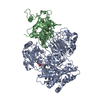
|
|---|---|
| 1 |
|
- Components
Components
| #1: Protein | Mass: 40142.375 Da / Num. of mol.: 1 Source method: isolated from a genetically manipulated source Source: (gene. exp.)  Production host: Insect cell expression vector pTIE1 (others) References: UniProt: U5LSK3, UniProt: Q9SVY5*PLUS |
|---|---|
| #2: Protein | Mass: 97163.977 Da / Num. of mol.: 1 Source method: isolated from a genetically manipulated source Source: (gene. exp.)  Production host: Insect cell expression vector pTIE1 (others) References: UniProt: Q38834 |
| #3: Chemical | ChemComp-ADP / |
-Experimental details
-Experiment
| Experiment | Method: ELECTRON MICROSCOPY |
|---|---|
| EM experiment | Aggregation state: PARTICLE / 3D reconstruction method: single particle reconstruction |
- Sample preparation
Sample preparation
| Component | Name: ZAR1-RKS1 with ADP complex / Type: COMPLEX / Entity ID: #1-#2 / Source: RECOMBINANT |
|---|---|
| Molecular weight | Value: 0.13 MDa / Experimental value: YES |
| Source (natural) | Organism:  |
| Source (recombinant) | Organism: Insect cell expression vector pTIE1 (others) |
| Buffer solution | pH: 8 |
| Specimen | Embedding applied: NO / Shadowing applied: NO / Staining applied: NO / Vitrification applied: YES |
| Vitrification | Instrument: FEI VITROBOT MARK IV / Cryogen name: ETHANE / Humidity: 100 % / Chamber temperature: 295 K |
- Electron microscopy imaging
Electron microscopy imaging
| Experimental equipment |  Model: Titan Krios / Image courtesy: FEI Company |
|---|---|
| Microscopy | Model: FEI TITAN KRIOS |
| Electron gun | Electron source:  FIELD EMISSION GUN / Accelerating voltage: 300 kV / Illumination mode: FLOOD BEAM FIELD EMISSION GUN / Accelerating voltage: 300 kV / Illumination mode: FLOOD BEAM |
| Electron lens | Mode: BRIGHT FIELD / Nominal magnification: 105000 X / Nominal defocus max: 900 nm / Nominal defocus min: 700 nm / Cs: 0.01 mm / C2 aperture diameter: 50 µm |
| Specimen holder | Cryogen: NITROGEN / Specimen holder model: FEI TITAN KRIOS AUTOGRID HOLDER |
| Image recording | Electron dose: 50 e/Å2 / Film or detector model: GATAN K2 SUMMIT (4k x 4k) |
- Processing
Processing
| EM software |
| ||||||||||||||||||||||||||||||||||||
|---|---|---|---|---|---|---|---|---|---|---|---|---|---|---|---|---|---|---|---|---|---|---|---|---|---|---|---|---|---|---|---|---|---|---|---|---|---|
| CTF correction | Type: PHASE FLIPPING AND AMPLITUDE CORRECTION | ||||||||||||||||||||||||||||||||||||
| Particle selection | Num. of particles selected: 2092456 | ||||||||||||||||||||||||||||||||||||
| Symmetry | Point symmetry: C1 (asymmetric) | ||||||||||||||||||||||||||||||||||||
| 3D reconstruction | Resolution: 3.7 Å / Resolution method: FSC 0.143 CUT-OFF / Num. of particles: 148718 / Symmetry type: POINT | ||||||||||||||||||||||||||||||||||||
| Atomic model building | Space: REAL | ||||||||||||||||||||||||||||||||||||
| Atomic model building | PDB-ID: 3TL8 Accession code: 3TL8 / Source name: PDB / Type: experimental model |
 Movie
Movie Controller
Controller


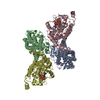
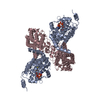
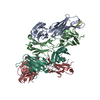
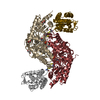
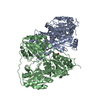
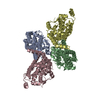
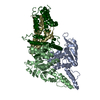

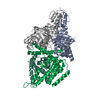
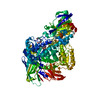
 PDBj
PDBj



